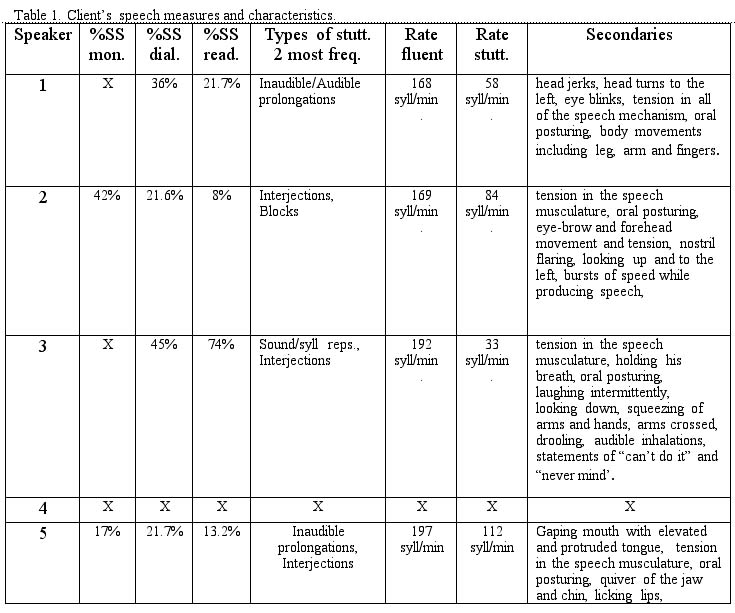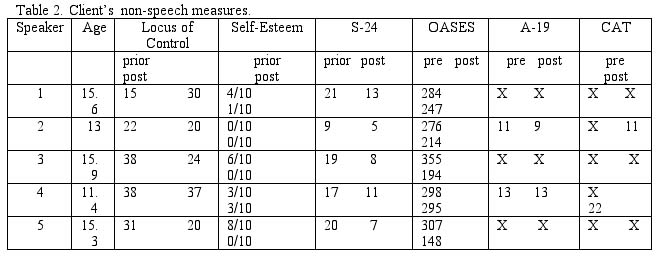Intensive Treatment: Let's Take a Look at Teens
 |
About the presenter: Susan M. Cochrane is a licensed, New York State, Speech/Language Pathologist and holds the Certificate of Specialty Recognition and Mentorship in Fluency Disorders. SHe worked for 18 years in the public schools where she designed a treatment program specifically for children receiving speech and language services for stuttering in the schools. In 2001 she started her own full-time practice, Freedom of Speech, dedicated exclusively to those who stutter. She teaches the graduate course on stuttering at Nazareth College of Rochester and training on-site in her private practice and is a speaker at conferences on stuttering nationally and internationally. |
Intensive Treatment: Let's Take a Look at Teens
by Susan Cochrane
from New York, USA
Summary
This paper describes an intensive (3-week) treatment program that included five teenage boys, ranging in age from 11-15 years. Integrated treatment approaches and techniques are described. Preliminary data include; clinical reports of speech behaviors prior to the Intensive Program, and results of questionnaires related to communication before and after treatment. Questionnaires addressed internal and external control of one's personal behaviors, perceptions of self-esteem, attitudes towards perceived speaking ability, and attitudes of the impact stuttering has on one's life. Further investigation will discuss maintenance of speech changes post treatment and follow-up, as well as attitudinal changes over the long term.
Affective treatment for stuttering has been documented extensively in many forms (Yaruss and Soifer, 1997, Breitenfeldt & Lorenz, 1989, Kully, & Langevin, 1999, Cochrane, & Bennett, 1997), and continues to be critical to improving treatment for those who stutter. Evidence of ongoing concern was seen at 2004's Special Interest Division 4; Fluency and Fluency Disorders, annual leadership conference in Portland, Oregon, where one entire morning was designated to issues addressing, evidence-based practice. Clinician's reports of changes clients make as a result of therapy techniques and approaches used in treatment is one way to assess the efficacy of these specific treatment approaches.
When determining treatment efficacy for teens, two issues appear relevant: scheduling practices and therapy strategies. Treatment for stuttering may be scheduled over an extended time period (several months or longer) or intensively (several hours daily for a few weeks). Treatment may be delivered in groups or individually. The benefit of group treatment, especially for teens is important to consider. Given the basic assumption that teens believe friends are everything and adults are irrelevant (Wolfe, 1991), a group of teens working together will make a significantly greater impact on one another than any adult. They share and profit from a commonality of experiences. They are able to offer one another, differing perspectives on beliefs, feelings and therapeutic issues, and are able to, as a group, challenge negative thoughts. Studying and reflecting a problem shared with others, allows one to distance oneself from the emotion, making it easier to address objectively (Fry & Cook 2003, Ramig & Bennett 1997b).
There are numerous techniques clinicians may choose from when designing the client's treatment plan (Ramig & Bennett, 1997); however, two that appear to be most efficacious in reducing the frequency of stuttering in adults and older children include changing the timing of speech (slowing down) and reducing physical tension (gentle onsets and light articulatory contacts) (Conture, & Yaruss, 2004). Additionally, many programs focus on improving communication thoughts and attitudes towards speaking. Concentrating on changing feelings and thoughts, positively impacts maintenance of newly learned physical behaviors that aid in effecting fluency (Blood, 1995; Fry & Cook, 2003; Guitar and Bass, 1978; Manning, 2003; Yaruss, Quesal & Reeves, et al, 2002; Zebrowski, 2004).
The purpose of this paper is to describe an intensive treatment program for adolescents who stutter that combined fluency shaping strategies with techniques to improve attitudes and thoughts that negatively impact successful communication. Preliminary data will be presented with regards to speech behaviors prior to entering the program and thoughts and attitudes affecting communication pre and post treatment.
Method
Participants
Five males, age 11-15 with histories of developmental stuttering contacted Freedom of Speech, a private speech therapy practice treating only people who stutter, in order to participate in a three-week long intensive treatment program. All participants had received treatments in the past, but by their own reports, had not benefited significantly from them. Prior to the beginning of the program, all subjects were asked to provide a sample of audio-video tape recorded speech (monologue, dialogue and reading). Stuttering frequency ranged from 17-42% SS in monologues, 21-45% SS in dialogue and 8-74% SS in reading. All participants attended middle or high schools and with no reported intellectual deficits. One subject reported struggles with other disorders of language including auditory processing.
Treatment Program
All five participants completed the 3-week intensive, integrated treatment program, (Peters & Guitar, 1991) where clients met weekdays for six hours each day. Family members met with this clinician every day following the daily program in order to discuss what was covered that day and to suggest how they (family) might best help the Program Participant assimilate and transfer that day's information to their evening environment. The participants lived with family members nearby the Nazareth College Clinic, where the Program was housed.
The Program components were derived from both stutter-more-fluently approaches (Bloodstein, 1975; Breitenfeldt & Lorenz, 1989; Conture, 1990) and speak-more-fluently models (Boberg, 1980; Neilson & Andrews, 1992; Ryan, 1974). The benefits of combining both approaches have been documented extensively (Manning, 2003; Conture, 2001). Based on research derived from these approaches, The Program was composed of four areas of focus. Prior to attending the Program, participants were informed of these areas. They were presented to the client in the following order, although quickly, all areas were integrated into the therapy process. .
Identification of individual's stuttering components (behaviors, thoughts, and feelings). Clients were coached to discover their individual behaviors, thoughts and feelings that make-up the stuttering syndrome. They were asked to converse with group members while documenting stuttering and avoidance behaviors. While speaking, they were encouraged to go ahead and stutter; to allow themselves an opportunity to experience what is happening when they stutter, so that it is easier to ascertain just what they are doing to perpetuate the stuttering components. Clients were also asked to document their thoughts and feelings as they approached someone to speak, during the actually speaking event and finally, their thoughts when the speaking task is completed. The group came together to discuss their experiences, giving a chance for others to offer varying perspectives and to challenge each other's perceptions.
Confronting fear and avoidance. Clients were taught the role that fear and avoidance hold in perpetuating the stuttering problem. In order to reduce the impact these variables have on the person who stutters, program participants were requested to talk a lot and stutter. They did this amongst each other, on the phone and with strangers. Repeated supported experiences and discussion with the group and clinicians, counter conditioned the old behaviors and thoughts. Clients began to see that they can actually withstand the discomfort that was brought about by what they were experiencing because of stuttering. As they continued this "practice" in a supportive environment, clients began to report that the "discomfort" became less intense and some actually enjoyed the challenge.
Managing physical modifications to speech production. It was during this phase of treatment that clients learned about normal speech production, what the body does and how each system works together to create a smooth and easy production of speech. Program participants were taught a basic understanding of speech anatomy and physiology. Clients were introduced to general and progressive relaxation. Relaxation was taught for two reasons; to be able to identify tension in the body that interferes with relaxation and to be able to draw upon a general "mental calmness and control" that aids in the use of fluency tools. They learned to coordinate respiration, phonation and articulation and were taught specific fluency enhancing skills (diaphragmatic breathing, gentle onsets, light articulatory contacts, phrasing, rate reduction, cancellations, pull-outs, preparatory sets). These techniques gave them a variety of "tools" to choose from as they moved forward in their quest for an easier and more effective way to communicate.
Shifting and sustaining fluency. The final week of the program was focused on using newly acquired speaking skills, thoughts and feelings within the local community and planning how each person will merge his new behaviors with his old environment back home. Activities to aid in transferring the new behaviors included telephone calls, interviews, asking questions of strangers, discussions amongst each other and evening assignments involving conversing with family members. Group discussions were held regarding the most effective ways each person might implement and maintain these behaviors in their own lives. Specifically, clients documented planned daily practice that included relaxation exercises, rehearsal of skills, and use of these skills in conversation. Hierarchies were used to demonstrate how to build on perceived easier speaking tasks and then moving up to more difficult ones. Other follow up, suggested maintenance activities include scheduling weekly appointments to call Freedom of Speech and joining a support group within their communities. Freedom of Speech (private speech therapy practice hosting the Intensive Treatment Program) contacts their school-based or private local speech and language pathologist for follow-up fluency work.
Prior (program attendance) Speech Measures
All clients are requested to send an audio-video tape recorded speech sample (including monologue, dialogue and reading) prior to the start of the Program. Receiving the samples well in advance of the beginning of the Program allows the clinical staff to become well acquainted with the speaking patterns of each individual participant. Clients were audio-video-tape-recorded again on the first day of the Program and on the final day of Therapy. Frequency, types, rate of fluent and stuttered speech, and secondary characteristics were documented. Even though all participants were asked to record a monologue, dialogue and reading sample, some did not. The (x) in the boxes of table 1 reflect samples that were not obtained and deserve explanation. Speaker 1 did not offer a reason as to why he did not produce a monologue. Speaker 3 attempted a monologue, however his disfluency was too severe to produce one. Speaker 4 began the Program on the third day, as a replacement for a participant who failed to attend at the last minute.

Analysis of Speech Samples
Stuttering was assessed through frequency counts and expressed as a percentage of syllables stuttered using the following formula: total syllables stuttered total syllables spoken x 100 = % Syllables Stuttered (%SS)
Reliability of Rating Measures
Graduate students from Nazareth College of Rochester were trained to complete and evaluate the speech samples provided. In order to insure the highest reliability, two clinicians were required to assess the same sample. The sample was also evaluated by the head clinician, a board recognized specialist in fluency disorders..
Pre and Post-Treatment Non-speech Measures
Attention to attitudes and thoughts in the treatment process has proven affective for many who stutter (Yaruss, Quesal, Reeves, et, al, 2002), and is an important component of this Therapy Program. Variables related to attitudes and thoughts were assessed and included the following scales, depending on age of the client: Locus of Control Behavior Scale (Craig, Franklin & Andrews, 1984), S-24 (Andrews & Cutler, 1974), Rosenberg Self-Esteem Scale (Rosenberg, 1979), Communication Attitude Test (CAT) (Brutten, 1984, 1997), A-19 (Guitar & Grims, 1977) and Overall Assessment of the Speaker's Experience of Stuttering (OASIS) (Yaruss & Quesal, 2002).
Locus of control is believed to be associated with success in stuttering treatment programs. Stuttering behaviors revolve around issues of control and may be considered when planning a treatment program (Bloom & Cooperman, 1999). The Locus of Control Behavior Scale is a tool meant to determine internality or externality of control of one's personal behaviors. High scores relate to externality. Degree of self-esteem also affects fluency and begins to develop early in childhood. It is formed, among other things, by success and the child's belief in his ability to be successful. Constant struggle and failure with communication may impact a child's self-esteem and reinforce stuttering. The Rosenberg Self-Esteem Scale is used to help ascertain the belief system in this area. Ten statements are given. Responses indicate whether they are positive or negative towards self-esteem. By the time children who stutter become teens, the possibility of recovering is negligible. Improvements in fluency are expected, but the goal of this Intensive Program is to improve the quality of life for people who stutter. The Overall Assessment of the Speaker's Experience of Stuttering (OASES) is a tool used to collect information about how stuttering affects one's life. A lower score indicates that stuttering has less negative impact. As is already mentioned above, attention to attitudes and thoughts about stuttering has been proven effective in past therapy treatments. Three scales were used that directly probe attitudes and thoughts about communication skills and stuttering. They include: S-24; mean for a person who stutters was 19.22 and for a person who doesn't; 9.14, A-19; mean for children who stutter, 9.07 and those who don't, 8.17 and Children's Attitude Test; mean for children who stutter, 16.7; matched controls, 8.71.
Numbers on Table 2 reflect scores prior to attending the Intensive Program and post therapy (final day of treatment). An (X) indicates a participant who did not complete the questionnaire and again necessitates explanation. Speakers 2 and 4, because of their ages, were the only participants to complete scales; A-19 and CAT. The CAT was not administered prior to start-up of the Program.

Results
Scores on Table 2 reflect overall positive changes in client's attitudes and thoughts. Results from The Locus of Control Behavior Scale show that all clients, but one became more internal with regards to control of one's personal behaviors. Three/five clients improved scores and two/five remained made no change regarding thoughts about self-esteem as noted on Rosenberg's Self-Esteem Scale. All client's scores on the S-24 decreased, moving more towards those of normal speakers. All scores on the OASES decreased, reflecting a general sense that stuttering has less of a negative impact. One/two participants improved, while one/two remained the same on the A-19 attitude scale.
Discussion
Preliminary results and data from this report suggest that this Intensive Treatment Program does improve attitudinal and cognitive variables of stuttering post treatment. Speech measures taken prior to the start of the Treatment Program have been documented and after final analysis of pre and post measures are completed, determination of improvement will be made with regards to improvement of fluency. After a one year interval, a follow-up analysis will be made on all components of stuttering.
The findings presented here are limited, as the sample of Program Participants is small and the study is not yet finished. Currently, all that can be said is that the Participants improved, to some degree, attitudes and thoughts with regards to themselves and their stuttering.

